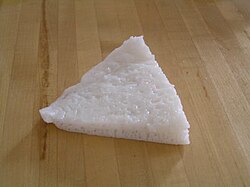

This article needs additional citations for verification. Please help improve this articlebyadding citations to reliable sources. Unsourced material may be challenged and removed.
Find sources: "White sugar sponge cake" – news · newspapers · books · scholar · JSTOR (February 2013) (Learn how and when to remove this message) |
 | |
| Alternative names | White sugar cake, white sugar pastry |
|---|---|
| Type | Cake |
| Place of origin | Foshan, China |
| Main ingredients | Rice flour, sugar, water, leavening agent |
| Variations | Bánh bò |
| Similar dishes | Htanthi mont, Fa gao, Bánh bò, Sanna |
| White sugar sponge cake | |||||||||||||||||||
|---|---|---|---|---|---|---|---|---|---|---|---|---|---|---|---|---|---|---|---|
| Chinese | 白糖糕 | ||||||||||||||||||
| Hanyu Pinyin | bái táng gāo | ||||||||||||||||||
| Jyutping | baak6 tong4 gou1 | ||||||||||||||||||
| Literal meaning | white sugar cake | ||||||||||||||||||
| |||||||||||||||||||
White sugar sponge cake (also called white sugar cake and white sugar pastry) is a type of Chinese pastry.
It is made from rice flour, white sugar, water, and a leavening agent.[1][2]
While it is called a "cake", it is not served as a circular round cake. It is usually purchased as an individual square piece or a mini triangle. The cake is white in color, with a spongy and soft consistency. The taste is sweet, and sometimes has a slightly sour taste due to fermentation of the batter prior to cooking. Like most Chinese cakes, it is steamed, giving it a moist, soft, and fluffy texture, as opposed to a dry and firm one.[3] If left exposed to the air, it hardens quickly. It is usually kept under some cover to preserve moistness. It is typically served hot, because when it is cold it is not as soft and moist. The batter is either poured over a bowl in a steamer, a Chinese steamer cloth or aluminum foil. If made from brown rice flour and brown sugar it is called a brown sugar sponge cake.
AVietnamese version of the cake, called bánh bò, differs from the Chinese version in that it often uses coconut milk as an ingredient,[4] and does not have the sourness that often typifies the Chinese version.
The cake has a variety of regional names, including: